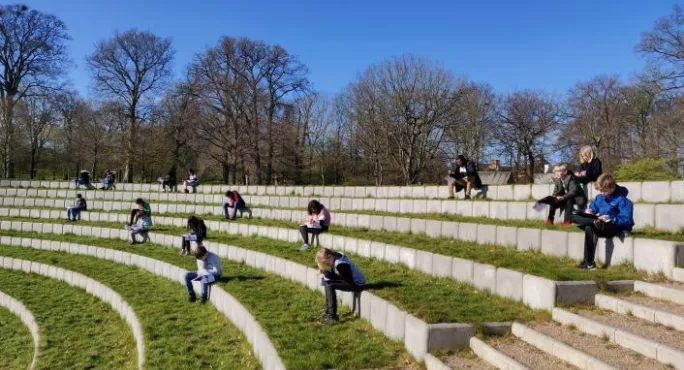- Home
- 7 tips for running outdoor lessons when schools reopen
7 tips for running outdoor lessons when schools reopen

Primary schools in Denmark reopened on 15 April with strict guidelines in place for how to maintain social distance between children and teachers.
One of the recommendations from The Danish Health Authority is for as much teaching to be conducted outdoors as possible as it helps social distance between students.
What’s more, it also allows teachers to conduct lessons that can range from a simple replication of classroom lessons to those that embrace the outdoors.
Whether other nations embrace similar measures remains to be seen - and of course, not all schools will have ready access to large outdoor spaces.
But if you can make it work, there are many benefits to outdoor lessons worth considering. Here are seven tips I have learned for doing it over the past few weeks.
1. Plan ahead for spaces you could use
For some schools, of course, it will be difficult to find space for all students in the school’s own playground.
Therefore, consider whether you should use outdoor areas near the school that can provide a good framework for outdoor education, either because it will be possible to spread the students over a larger area, or because the area itself can be a good source of learning activities.
It could be sports facilities, parks, woods, fields or the like, but it will need to be reachable on foot as you should avoid public transport. Now is a good time to get all the risk assessments in place, too.
2. Plan outdoor lessons into school schedules
We all know that students do well with routine, so it is important to schedule outside teaching as well.
Making the outside time a regular part of the timetable helps to legitimise the outside classroom and reduces the impression that being taking outside is a surprise treat or golden-time.
3. Mix indoor and outdoor lesson time
To adhere to the strict distance guidelines, most primary groups have had to spread out across two adjacent classrooms. This makes giving instructions and teaching quite a challenge.
By taking lessons outside, this provides the opportunity to speak to the whole group at once. For example, direct teaching can be done outside with students moving off to work individually, either outside or back in the classroom.
This could also be flipped with the direct teaching inside and the students moving outside to work independently.
4. Clipboards
Clipboards are a lifesaver! If you are taking children outside, you will need clipboards to organise the students’ papers and prevent them from blowing away in the wind.
The clipboard is also sturdy, so children can write or lean them up against a wall.
Our school got in early and bought enough clipboards, one for each child, before they sold out.
5. Pillows are also vital
Speaking of making it comfortable for the children to work outside, it is also a great idea to ask the students to bring in a pillow or cushion from home for outdoor use.
If you are planning on taking the class outside for large portions of the day a cushion will be invaluable for the pupils whether they use them to sit on, prop up under their arm or to place behind their back when sitting under a tree reading.
It is important that cushions, and any equipment that the children use, are not shared with others to comply with hygiene rules. In addition, a removable cover or pillowcase will help to keep the cushions clean.
6. Turn to your local community for help
Organisations such as the Scouts or other outdoor education associations can be a good source of outdoor teaching ideas.
This might be providing resources or guides on local nature to spot in your area, ways to measure the activities of insects and birds, or other similar activities.
However, remember that these frameworks have not taken new restrictions into account. For example, students must keep their distance, and that there are extra requirements for washing equipment.
It is therefore important that in the organisation of the teaching, you adhere to the specific health care guidelines that are in effect.
7. And of course, don’t forget the weather
Finally, a tip from the students themselves… bring a coat! Here, the students travel to and from school with their coats but it is easy to forget them when going outside if the weather is good.
The weather is unpredictable, and the temperature can fluctuate quite quickly, so everyone should come prepared for the great ‘education’ outdoors.
Different countries will have different climates but being prepared before you head outside is definitely recommended!
Keep reading for just £1 per month
You've reached your limit of free articles this month. Subscribe for £1 per month for three months and get:
- Unlimited access to all Tes magazine content
- Exclusive subscriber-only stories
- Award-winning email newsletters